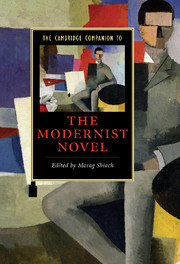Book contents
- Frontmatter
- Reading the modernist novel: an Introduction
- 1 Modernists on the art of fiction
- 2 Early modernism
- 3 Remembrance and tense past
- 4 Consciousness as a stream
- 5 The legacies of modernism
- KEY NOVELISTS
- 6 James Joyce and the languages of modernism
- 7 Tradition and revelation: moments of being in Virginia Woolf’s major novels
- 8 Wyndham Lewis and modernist satire
- 9 D. H. Lawrence: organicism and the modernist novel
- 10 Joseph Conrad’s half-written fictions
- 11 Djuna Barnes: melancholic modernism
- 12 William Faulkner: an impossibly comprehensive expressivity
- 13 Writing lives: Dorothy Richardson, May Sinclair, Gertrude Stein
- 14 C. L. R. James, Claude McKay, Nella Larsen, Jean Toomer the ‘black Atlantic’ and the modernist novel
- 15 Situating Samuel Beckett
- Further reading
- Index
7 - Tradition and revelation: moments of being in Virginia Woolf’s major novels
from KEY NOVELISTS
Published online by Cambridge University Press: 28 July 2007
- Frontmatter
- Reading the modernist novel: an Introduction
- 1 Modernists on the art of fiction
- 2 Early modernism
- 3 Remembrance and tense past
- 4 Consciousness as a stream
- 5 The legacies of modernism
- KEY NOVELISTS
- 6 James Joyce and the languages of modernism
- 7 Tradition and revelation: moments of being in Virginia Woolf’s major novels
- 8 Wyndham Lewis and modernist satire
- 9 D. H. Lawrence: organicism and the modernist novel
- 10 Joseph Conrad’s half-written fictions
- 11 Djuna Barnes: melancholic modernism
- 12 William Faulkner: an impossibly comprehensive expressivity
- 13 Writing lives: Dorothy Richardson, May Sinclair, Gertrude Stein
- 14 C. L. R. James, Claude McKay, Nella Larsen, Jean Toomer the ‘black Atlantic’ and the modernist novel
- 15 Situating Samuel Beckett
- Further reading
- Index
Summary
Virginia Woolf (1882-1941) was determined to produce not only something beautiful in her art but also something all her own. She was, as her numerous diaries and essays demonstrate, intrigued by notions of time, space and consciousness. The impact of such influences upon the creation of identity is a central theme in her work and the representation of these complicated ideas in fiction was her greatest challenge. Woolf wrote in 1921, 'If a writer were a free man and not a slave, if he could write what he chose, not what he must … there would be no plot, no comedy, no tragedy, no love interest.' The traditional plot-led structure of 'the novel' was a source of frustration for her as she believed that it did not reflect what it felt like to be alive. 'Life', she wrote, 'is not a series of gig lamps symmetrically arranged; life is a luminous halo.' Woolf’s nine novels represent her negotiation of, and response to, that persistent frustration as she worked towards forging a new form of writing, one that would reflect the 'halo', the 'uncircumscribed spirit' of life. Her resultant experiments with narrative structure enabled her to explore new ways of representing time, space and consciousness in her works.
In 'A Sketch of the Past' (1941), Woolf suggested that most people spend their lives wrapped in a kind of 'cotton wool' that limits their perceptions, protecting them from strong sensations. 'From this,' she states, 'I reach what I might call a philosophy; … that behind the cotton wool is hidden a pattern.' For Woolf, this 'pattern' is a paradigm of connection, of universal meaning and purpose normally unseen or unnoticed in everyday life.
- Type
- Chapter
- Information
- The Cambridge Companion to the Modernist Novel , pp. 112 - 125Publisher: Cambridge University PressPrint publication year: 2007
- 5
- Cited by

